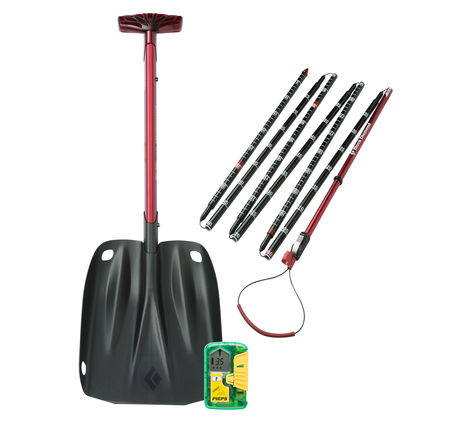What’s in Your Backcountry Backpack?
Do you really have the necessary gear?
There is a plethora of information out there on backcountry gear. But how do you decipher through it all to find what you really need? We are here to break down the backcountry gear guide and simplify it for your situation.
The reality is we all have different agendas when heading into the backcountry that call for slightly different items in our bag. This list can be used directly or tweaked for your situation. As a quick note before we dive in, if you don’t know how to appropriately use your gear or the items in your bag they are useless. So make sure to get familiar with the items in your bag and learn when and how they are used. This is KEY!
 Save a Life
Save a Life
Ok first off you will need a Beacon, Probe, and Shovel. These are the mandatory items for saving your buddies life. Beacons have come a long way since their conception and are now offered at many different price points each with different modes and settings. The probe is used for measuring the depth of the buried victim and pinpointing his exact location. The industry standard for probe length is 240cm so be sure to get one at least that long. As far as backcountry shovels go most people want something that is light and compact for carrying and stuffing into the back but strong and big enough to move large amounts of snow if need be. These are often offered in many different sizes but it’s important to get the necessities. For a quick tutorial on what should be in your First Aid kit watch TGR’s Safety Week Video.
Crucial Items
Other important items to include in your backpack are extra gloves, extra layers and a down jacket. A map of the area and a compass are no brainers for your backpack and like the rescue gear you should be trained and familiar with how they work. A multi-tool comes in handy often and takes up almost no space. You’ll also want a good headlamp or flashlight for those early mornings or dark evenings. Did you know most avalanches happen on a slope between 30 and 50 degrees? Carrying an inclinometer will instantly let you know if you are on a slope that could slide.
Pro Tip: pack your puffy and extra layers in a good quality dry seal bag. Not only will it guarantee dry clothes but it can also be used as an anchor to your shelter in windy conditions.
Last But Not Least
Final items include the smaller yet still important items. Hydration is important for any and every physical activity, water purifiers or tablets may also come in handy in case you run out. Matt from here at the shop carries an 8 inch rubber tube or straw for an on-the-go hydration station. You can bring it out when there is some fresh snow melt running off crags and take a quick sip or use it to top off you water bottle.
You'll also need some food. Personally I’m a snacker and when I’m out and about calories burn off quick. I always bring extra Cliff bars, Gu’s, and energy blocks. For finding the right flavors I like to walk into a store and buy a variety of flavors to find the ones that suit me, then stick with those. An emergency blanket or bivy should be carried for those extreme situations where you may have to stay overnight, or just to keep a victim that is in shock from going into hypothermia.
For more information and update reports visit SierraAvalancheCenter. You ALWAYS check the avalanche reports and website before heading out. SAC also has a list of all the local avalanche safety course providers. If you are serious about going into the backcountry please take the necessary courses to insure you and your groups safety.
Don’t forget you can find all these essential items and much more right here at Granite Chief. We also have a well-versed and experienced staff of backcountry experts that can answer any of your questions or concerns. We also have a great selection of books so you can further your personal education.
The Checklist
-Beacon
-Probe
-Shovel
-Map & Compass
-First Aid Kit
-Waterproof Matches, Lighter, or Fire Start Kit
-Extra Layers (puffy jacket, gloves, dry base layers)
-Water
-Food (bars, gels, chews)
-Multi-tool
-Emergency blanket or bivy
Staff Tip: John from the shop has an unusual item in his backcountry backpack when snowmobiling. He packs a tampon in his fire starter kit. In case of an emergency unwrap the tampon dip it into your gas tank and then use it to start his fire!
What did we forget? Leave a comment bellow and let us know.